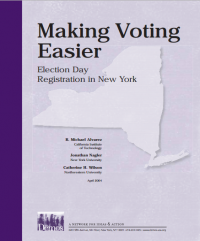Voter registration is intended to ensure that voters who are eligible to vote are able to do so, and that non-eligible individuals cannot cast ballots. A voter registration list enables election workers to authenticate eligible voters at the polls. Voter registration also serves to provide lists of persons (i.e., registered voters) who should receive notices informing them when elections are forthcoming, and where they should go to vote.
However, there are costs associated with any system of voter registration. Principally, voter registration adds another step to the voting process and thus creates a barrier to voting. In order to vote in New York people must know how to register, and must do so well in advance of any election. When people move, failure to update their registration can make them ineligible to vote. And people who show up at the polls may be disenfranchised if there are errors in the registration system.
Problems with voter registration have led to two major reforms in the last fifteen years. The National Voter Registration Act of 1993 ("NVRA," commonly referred to as "motor voter") requires states to provide voter registration material at sites where citizens register motor vehicles. It also requires states to provide agency-based registration, where state offices that provide public assistance, services to persons with disabilities, and other aid must offer registration opportunities to each "applicant for services." And, it requires states to offer and accept mail-in forms for voter registration. The Help America Vote Act of 2002 (HAVA) requires states to create a statewide, central voter registration system. Both NVRA and HAVA provide challenges for the New York State voter registration system as they establish legal mandates for services the system must provide. Notably, these legal mandates cross jurisdictional lines of state and county.
Six states currently use EDR. Their collective experience can speak to the advantages of election day registration and to the challenges and consequences of its implementation. When studying the likely impact of EDR on California, Alvarez and Ansolabehere looked at the results from two metropolitan areas in states using EDR -- Minneapolis-St. Paul, Minnesota and Milwaukee, Wisconsin -- and found:2
In the long run, states that have adopted EDR show an increase in participation rates of 3 to 6 percentage points of the voting-age population. In California, such an increase would translate into as many as 1.2 million new voters.
Voting rates of young people and of people who have recently moved are especially likely to improve, but the partisan composition of the electorate may be little changed.
Fraud is minimal, in part because of precautions taken by the states.
Administration is in some ways more complicated but in other ways improved. The quality of service at the polling place is no worse, and may be better. With EDR almost all registrations are done under the auspices of the election office and after providing some form of identification. Fewer people will register by mail, through registration drives, or at other government offices. The main difficulty is making sure that new voters go to the right polling place.
They also identified three keys to proper implementation:
Requirements for proper identification, including driver's licenses, utility bills, or affidavits signed by registered voters.
Development and implementation of procedures that will get prospective voters to the right polling places.
Changes in polling place organization and increased polling place staff.
Based on their earlier analysis, and our further study of EDR, we are confident that EDR can be established in New York in such a way as to minimize the potential problems with fraud and election administration. New York can join a growing number of states considering the use of election day registration to make voting easier for their citizens, in particular, Connecticut and Massachusetts.3 In A.5762, potential problems are minimized as there is no procedural change at the polling place.
